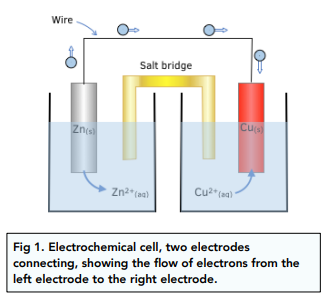Electrode Potentials and Electrochemical Cells - Electrochemical Cells Reactions (A-Level Chemistry)
Electrochemical Cells Reactions
Calculating the EMF
Using Standard Electrode Potentials to Calculate Cell EMFs
When you connect two half cells to form an electrochemical cell, electrons flow from the more negative electrode to the more positive electrode. A voltage is produced. Understanding these fundamental principles is crucial for students, especially those aiming for Chemical Engineering work experience, as it underpins many industrial processes and design considerations.
Using the direction of flow of electrons and the E⦵ values of each electrode, you can work out the standard cell potential (EMF) of an electrochemical cell.
The half-cell with the more negative E⦵ is on the left, as this is most easily oxidised.
EMF = E⦵ (right electrode) – E⦵ (left electrode)
This can also be written as:
EMF = E⦵ (reduced) – E⦵ (oxidised)
Example: Zinc and Copper Cell


What are the Half Equations?
The half equations can be found using the direction of the electrons.
The electrons flowing from the more reactive element (metal with the most negative electrode potential) to the less reactive element (metal with the most positive electrode potential).
The direction of each half equation can be determined using the electrode potentials in the table.
The electrode with the more negative electrode potential more readily releases electrons.
Therefore electrons flow from zinc to copper – Zinc is oxidised, Copper is reduced.
The half equations corresponding to Figure 3 are:

What is the Full Equation?
The half equations can be combined to form the full equation:

Electrons gained in the reduction have to balance the electrons lost in the oxidation.
Worked Example: What is the standard cell potential (EMF) of the Zn/Cu electrochemical cell?
1. Write the 2 half equations.

2. Use the data tables to look up the EMF of each half-cell

3. Work out the EMF
EMF = E⦵ (right electrode) – E⦵(left electrode)
The half-cell with the more negative EMF is on the left – here it is zinc.
EMF = 0.34 – (-0.76) = +1.10V
The Electrochemical Series
Electrochemical Series
An electrochemical series is a series of elements arranged in order of their standard electrode potentials.
The electrode potentials are always written in the direction of the reduction equation.
It can be used to work out the EMF of an electrochemical cell by using the E⦵ values.
Directions of each half equation of an electrochemical cell can also be determined using the electrochemical series. These two equations can then be combined to produce the full ionic equation happening in the electrochemical cell.
The more negative E⦵ value is the half equation that goes in the forward (reduction) direction.
EMF and Reaction Feasibility
A positive overall EMF indicates that the reaction is feasible in the directions indicated by the respective half equations.
This can also be principle also applies to disproportionation reaction. The electrode potentials for the two half equations in the disproportionation reaction are used to calculate EMF. If EMF is positive, the disproportionation reaction will occur.
However, this prediction is only correct under standard conditions.
To determine if the reaction is likely to occur, we must also consider the reaction conditions, reaction kinetics and Gibbs Free Energy of the reaction.
For example, a reaction may be feasible in terms of the EMF, but have a very high activation energy, and so may not proceed at a given temperature.
Standard electrode potentials are directly proportional to the total entropy change of the reaction. EMF is linked to Gibbs Energy by the equation:

Where n = number of moles of electrons transferred
F = Faraday Constant
Electrode potentials are a measure of the tendency of an electrode to oxidize or reduce in an electrochemical cell. The electrode potential is a measure of the potential difference between the electrode and a reference electrode, and it can be used to predict the direction of electron flow in an electrochemical cell.
Electrochemical cells are devices that convert chemical energy into electrical energy or vice versa. These cells consist of two electrodes, one of which is the anode and the other the cathode, that are immersed in an electrolyte solution. The flow of electrons between the electrodes is driven by the difference in electrode potentials, which can be used to power an external circuit or to generate a current.
Electrochemical cell reactions are chemical reactions that occur in an electrochemical cell and involve the transfer of electrons between the anode and cathode. These reactions can be either oxidation-reduction reactions, where the anode oxidizes and the cathode reduces, or galvanic cell reactions, where the anode corrodes and the cathode deposits metal. The direction and rate of the reaction is determined by the difference in electrode potentials and the concentration of the reactants in the electrolyte solution.
The direction of electron flow in an electrochemical cell is determined by the difference in electrode potentials. If the anode has a more negative electrode potential than the cathode, electrons will flow from the anode to the cathode, while if the cathode has a more negative electrode potential than the anode, electrons will flow from the cathode to the anode. The direction of electron flow can be predicted using the Nernst equation and the concentration of the reactants in the electrolyte solution.
A reference electrode is used in electrochemical cells to provide a fixed potential that can be used to compare the electrode potentials of other electrodes. The reference electrode is typically made of a metal or a metal salt and is used as a point of reference for measuring the electrode potential of the other electrodes in the cell. The use of a reference electrode allows for accurate and consistent measurements of electrode potentials in electrochemical cells.
The study of electrode potentials and electrochemical cells is important in chemistry because it provides a deeper understanding of the underlying processes that drive the conversion of chemical energy into electrical energy or vice versa. This knowledge can be applied to a wide range of fields, including batteries, fuel cells, and solar cells, and can help researchers to develop new and more efficient energy storage and conversion technologies. By studying electrode potentials and electrochemical cells, we can gain a better understanding of the fundamental principles that govern the interaction between matter and energy.






Still got a question? Leave a comment
Leave a comment